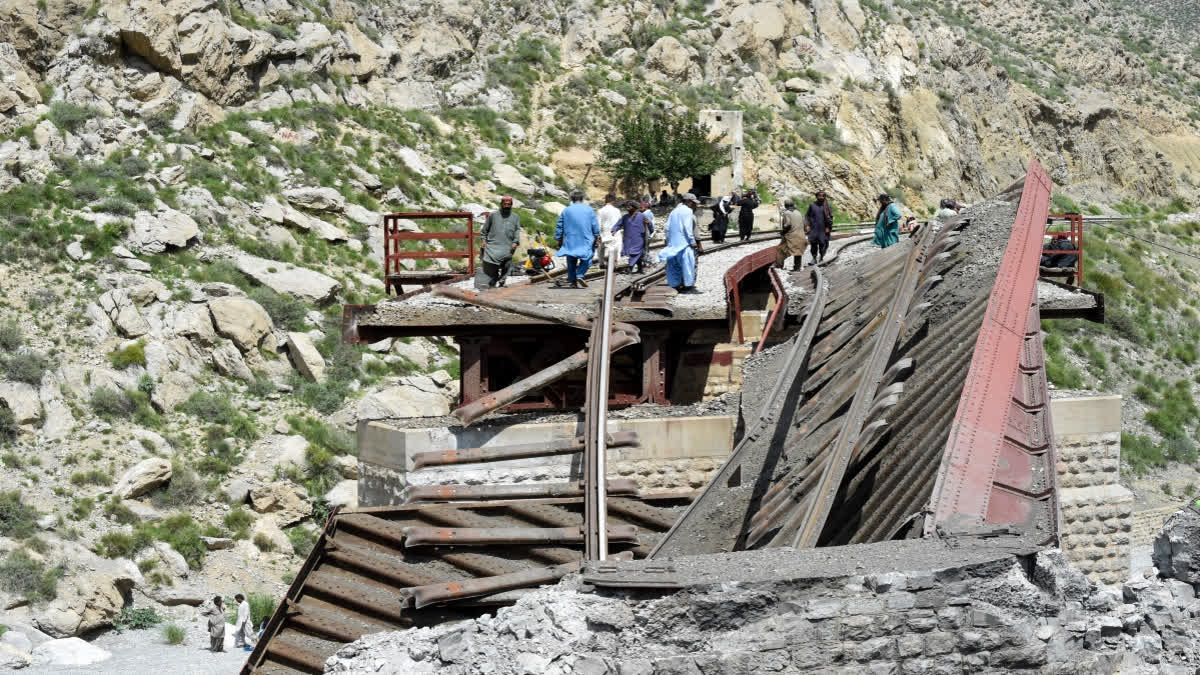New Delhi: A series of terror attacks in 10 districts across Balochistan province since last Sunday that claimed the lives of over 70 people, including civilians and security personnel, has again brought to focus the Baloch separatist issue.
The Balochistan Liberation Army (BLA) has claimed responsibility for the attacks that targeted police stations, railway lines and vehicles. Of the over 70 victims, 23 were killed when the gunmen blocked a key highway, forced passengers out of a bus and shot them after checking their identity cards.
However, after launching what it called 'Operation Herof', the BLA on Monday claimed responsibility for killing 102 Pakistani soldiers. The BLA is a Baloch ethnonationalist militant organisation based in Afghanistan. BLA perpetrates its terror activities from its safe havens scattered across Southern Afghanistan into Pakistan’s largest province of Balochistan, where it frequently carries out carnage against the Pakistan Armed Forces, civilians and foreign nationals.
Since the early 2000s, the BLA launched a violent struggle against Pakistan for self-determination for the Baloch people and the separation of Balochistan from Pakistan. It has been listed as a terrorist organisation by Pakistan, the UK and the US.
Who are the Baloch people?
The Baloch people are an ethnic group native to the Balochistan region, which spans across southwestern Pakistan, southeastern Iran, and southern Afghanistan. The Baloch have maintained a distinct identity despite centuries of external influence and geopolitical changes.
The majority of the Baloch reside within Pakistan. About 50 per cent of the total Baloch population lives in the Pakistani province of Balochistan, while 40 per cent are settled in Sindh and a significant albeit smaller number reside in Pakistani Punjab. They make up 3.6 per cent of Pakistan’s total population, and around 2 per cent of the populations of both Iran and Afghanistan.
The Baloch diaspora is spread across the Persian Gulf, Oman, Turkmenistan, and East African countries, particularly Kenya and Tanzania, due to historical trade, migration, and displacement.
The Baloch are believed to have migrated from the Caspian Sea region to their current homeland around the 12th century. Their origins are debated, with theories linking them to various ancient peoples, including the Parthians and Aryans.
The majority of Baloch are Sunni Muslims, adhering primarily to the Hanafi school of thought. There are also small communities of Shia Muslims and Zikris, a sect with distinct religious practices centered in the coastal areas of Balochistan. Despite religious affiliations, Baloch society tends to be less conservative compared to other regions, with tribal customs often holding greater influence over everyday life.
What does the Balochistan region cover?
Balochistan is a vast, arid, and mountainous region and is divided into three main areas. The largest part of Balochistan lies within Pakistan, where it is a province covering nearly 44 per cent of the country’s total land area. Iranian Balochistan, known as Sistan and Baluchestan province, is situated in southeastern Iran. Afghan Balochistan comprises a smaller area in southern Afghanistan, mainly within the provinces of Nimroz, Helmand, and Kandahar.
In Pakistan, Balochistan is the largest of the country’s four provinces. It is bordered by the Pakistani provinces of Khyber Pakhtunkhwa to the north-east, Punjab to the east and Sindh to the south-east. It shares international borders with Iran to the west and Afghanistan to the north and is bound by the Arabian Sea to the south.
What is the genesis of the Balochistan separatist movement?
The Balochistan separatist movement is a long-standing insurgency in the Balochistan region, primarily located in southwestern Pakistan, but also encompassing parts of southeastern Iran and southern Afghanistan. The movement is rooted in ethnic, cultural, economic, and political grievances, with separatist factions seeking greater autonomy, independence, or full sovereignty for the Baloch people.
Balochistan’s modern-day separatist movement has roots going back to the colonial era. The region was an independent territory with its own tribal governance until the British Empire integrated it into British India in the 19th century. This colonial administration often played Baloch tribes against each other, which sowed seeds of discontent.
Upon the partition of India in 1947, Balochistan became part of Pakistan, but the integration was contentious. The Khan of Kalat, the ruler of a significant portion of Balochistan, initially sought independence but was pressured into acceding to Pakistan in 1948. This accession is viewed by many Baloch as coerced, laying the foundation for separatist sentiments.
In Pakistan’s Balochistan province, insurgencies by Baloch nationalists have been fought in 1948-50, 1958–60, 1962–63 and 1973–1977, with the ongoing insurgency beginning in 2003.
Baloch separatists argue they are economically marginalised and poor compared to the rest of Pakistan. Balochistan is rich in natural resources such as gold, diamonds, silver, and copper but the people in the province are among the poorest in Pakistan. The BLA is the most widely known Baloch separatist group. Since 2000 it has conducted numerous deadly attacks on Pakistani military troops, police, journalists, civilians and education institutions. Other separatist groups include Lashkar-e-Balochistan and the Balochistan Liberation United Front (BLUF).
The China-Pakistan Economic Corridor (CPEC), a major project under Chinese President Xi Jinping’s pet Belt and Road Initiative (BRI), runs through Balochistan and this has intensified the conflict. While the Pakistani government views CPEC as an economic boon, many Baloch see it as another attempt to exploit their resources without benefiting the local population. Attacks on CPEC-related projects and personnel, particularly Chinese nationals, have increased in recent years. The deep-sea Gwadar Port on the Arabian Sea, which is part of the CPEC, is located in Balochistan.
How has the Pakistan government’s response to the separatist movement been?
Pakistan’s response has primarily been military, with ongoing operations aimed at crushing the insurgency. This approach has often led to further alienation among the Baloch populace. Human rights activists have accused nationalist militants and the Pakistan government of human rights abuses in its suppression of the insurgency. According to Amnesty International, in Pakistan, over 10,000 Baloch have disappeared since 2011.
Pakistan has accused neighboring countries, including India, of supporting Baloch separatist groups as part of a broader regional rivalry. While India denies any such involvement, it has occasionally raised concerns about human rights abuses in Balochistan at international forums.
Following the latest series of attacks claimed by the BLA, Pakistan Prime Minister Shehbaz Sharif went to Balochistan’s capital Quetta on Thursday on a one-day visit to review the security and law and order situation in the province. While Sharif has vowed to crack down on terrorism, Interior Minister Mohsin Naqvi said that the entire national leadership was “working towards a solution” to address the province’s issues.
Meanwhile, the Pakistani media, while coming down heavily on the government for what it described as “intelligence failure” that led to the attacks, called for a fresh approach to bring peace in the province without further alienating the Baloch people.



